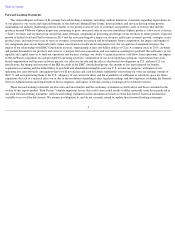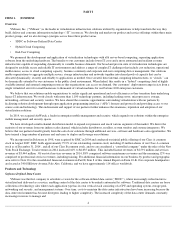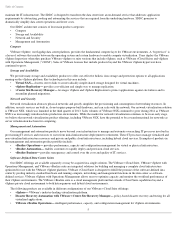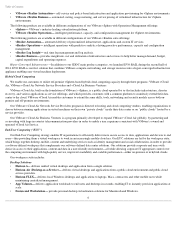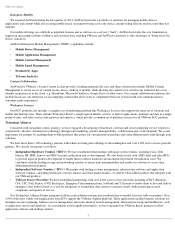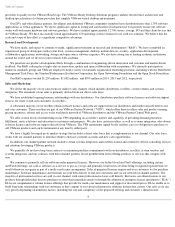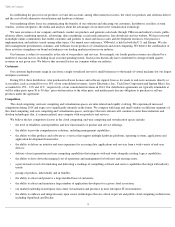VMware 2014 Annual Report Download - page 15
Download and view the complete annual report
Please find page 15 of the 2014 VMware annual report below. You can navigate through the pages in the report by either clicking on the pages listed below, or by using the keyword search tool below to find specific information within the annual report.
Table of Contents
We expect to face increasing competition that could result in a loss of customers, reduced revenues or decreased operating margins.
The virtualization, cloud computing, end-user computing and software-defined data center industries are inter-related and rapidly evolving.
We experienced increased competition during 2014 and expect it to remain intense going forward. For example, Microsoft continues to improve
its virtual infrastructure and virtual management products and is expected to release updated versions of its Hyper V virtualization product and
CloudOS private cloud platform. Microsoft also offers IaaS capabilities in Azure with a similar hybrid cloud message. We also face competition
from other companies that have announced a number of new product initiatives, alliances and consolidation efforts. For example, Citrix Systems
continues to enhance its end-user desktop and mobility offerings and their networking and cloud platform offerings. IBM, Google and Amazon
have existing cloud computing offerings and announced new cloud computing initiatives. Additionally, open source technologies for
virtualization, containerization, and cloud platforms such as Xen, KVM, Docker, Rocket, and OpenStack provide significant pricing competition,
and enable competing vendors to leverage open source technologies like OpenStack to compete directly with our SDDC initiative. Enterprises
and service providers have also shown significant interest in building their own clouds based on open source projects such as OpenStack. Other
companies have indicated their intention to expand offerings of virtual management and cloud computing solutions as well. Additionally, our
hybrid cloud computing offering, which allows enterprises to pool internal and external IT resources running on a common vSphere
infrastructure, competes with low-cost public cloud infrastructure offerings such as Amazon Web Services, Microsoft Azure, IBM SoftLayer
and Google Compute Engine.
Following our acquisition of Nicira and the resulting release of our NSX product, a number of competitors announced software-defined
networking offerings. For example, Cisco announced its Application Centric Infrastructure initiative.
We believe that the key competitive factors in the virtualization and cloud computing spaces include:
Existing and future competitors may introduce products and services in the same areas we serve or intend to serve, and competing products
and services may have better performance, lower prices, better functionality and broader acceptance than our products and services. Our
competitors may also add features to their virtualization, end-user and cloud computing products similar to features that presently differentiate
our product offerings from theirs. Many of our current or potential competitors also have longer operating histories, greater name recognition,
larger customer bases and significantly greater financial, technical, sales, marketing and other resources than we do. This competition could
result in increased pricing pressure and sales and marketing expenses, thereby materially reducing our operating margins, and could also prevent
our new products and services from gaining market acceptance, thereby harming our ability to increase, or causing us to lose, market share.
Increased competition also may prevent us from entering into or renewing service contracts on terms similar to those that we currently offer
and may cause the length of our sales cycle to increase. Additionally, some of our competitors and potential competitors supply a wide variety of
products and services to, and have well-established relationships with, our current and prospective end users. For example, small to medium
sized businesses and companies in emerging markets that are evaluating the adoption of virtualization-based technologies and solutions may be
inclined to consider Microsoft solutions because of their existing use of Windows and Office products. Some of these competitors have in the
past and may in the future take advantage
13
•
the level of reliability, security and new functionality of product offerings;
•
the ability to provide comprehensive and scalable solutions, including management and security capabilities;
• the ability to offer products and services that support multiple hardware platforms, operating systems, applications and application
development frameworks;
• the ability to deliver an intuitive end-user experience for accessing data, applications and services from a wide variety of end-user
devices;
•
the ability to effectively run traditional IT applications and emerging applications;
•
the proven track record of formulating and delivering a roadmap of virtualization and cloud computing capabilities;
•
the ability to attract and preserve a large installed base of customers;
•
pricing of products and services, individually and in bundles;
•
the ability to attract and preserve a large number of application developers to develop to a given cloud ecosystem;
• the ability to create and maintain partnering opportunities with hardware vendors, infrastructure software vendors and cloud service
providers;
•
the ability to develop robust indirect sales channels; and
•
the ability to attract and retain cloud, virtualization and systems experts as key employees.


